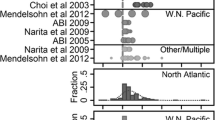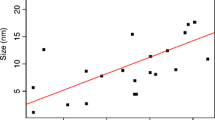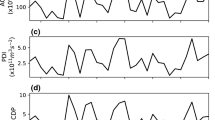Abstract
High-resolution climate model simulations and a tropical cyclone damage model are used to simulate the economic damage due to tropical cyclones. The damage model produces reasonable damage estimates compared to observations. The climate model produces realistically intense tropical cyclones over a historical simulation, with significant basin scale correlation of the inter-annual variability of cyclone numbers to observed storm numbers. However, the climate model produces too many moderate tropical cyclones, particularly in the N. Pacific. Annual mean cyclone damage with simulated storms is similar to estimates with the damage model and observed storms, and with actual economic losses. Ensembles of future simulations with different mitigation scenarios and different sea surface temperatures (SSTs), as well as societal changes, are used to assess future projections of cyclone damage. Damage estimates are highly dependent on the internal variability of the coupled system. Using different ensemble members or different SSTs affects damage results by ±40 %. Experiments indicate that despite decreases in storm numbers in the future, strong landfalling storms increase in E. Asia, increasing global storm damage by ∼50 % in 2070 over 2015. Little significant benefit is seen from mitigation, but only one ensemble is available. Projected increases in vulnerable assets increase damage from simulated storms by more than threefold (∼300 %, assuming no adaptation) indicating future growth will swamp potential changes in tropical cyclones.



Similar content being viewed by others
References
Bacmeister JT, Wehner MF, Neale RB, Gettelman A, Hannay C, Lauritzen PH, Caron JM, Truesdale JE (2014) Exploratory high-resolution climate simulations using the Community Atmosphere Model (CAM). J Climate 27 (9):3073–3099. doi:10.1175/JCLI-D-13-00387.1
Bacmeister JT, Reed KA, Hannay C, Lawrence P, Bates S, Truesdale JE, Rosenbloom N, Levy M (2016) Projected changes in tropical cyclone activity under future warming scenarios using a high-resolution climate model. Clim Chang:1–14. doi:10.1007/s10584-016-1750-x
Bakkensen LA, Mendelsohn RO (2016) Risk and adaptation: evidence from global hurricane damages and fatalities. Journal of the Association of Environmental and Resource Economists 3(3):555–587. doi:10.1086/685908
Bresch DN (2014) CLIMADA Model Code and Description
Chen X, Nordhaus WD (2011) Using luminosity data as a proxy for economic statistics. Proceedings Natl Academy Sci 108(21):8589–8594. doi:10.1073/pnas.1017031108
Done JM, Bruyère CL, Ge M, Jaye A (2014) Internal variability of North Atlantic tropical cyclones. J Geophys Res Atmos 119(11):2014JD021,542. doi:10.1002/2014JD021542
Done JM, PaiMazumder D, Towler E, Kishtawal CM (2015) Estimating impacts of North Atlantic tropical cyclones using an index of damage potential. Clim Chang:1–13. doi:10.1007/s10584-015-1513-0
Elvidge CD, Imhoff ML, Baugh KE, Hobson VR, Nelson I, Safran J, Dietz JB, Tuttle BT (2001) Night-time lights of the world: 1994–1995. ISPRS J Photogramm Remote Sens 56(2):81–99
Emanuel K (2005) Increasing destructiveness of tropical cyclones over the past 30 years. Nature 436(7051):686–688. doi:10.1038/nature03906
Holland G, Bruyère CL (2013) Recent intense hurricane response to global climate change. Clim Dyn 42(3-4):617–627. doi:10.1007/s00382-013-1713-0
Kay JE, Deser C, Phillips A, Mai A, Hannay C, Strand G, Arblaster JM, Bates SC, Danabasoglu G, Edwards J, Holland M, Kushner P, Lamarque JF, Lawrence D, Lindsay K, Middleton A, Munoz E, Neale R, Oleson K, Polvani L, Vertenstein M (2014) The Community Earth System Model (CESM) large ensemble project: a community resource for studying climate change in the presence of internal climate variability. Bull Amer Meteor Soc. doi:10.1175/BAMS-D-13-00255.1
Knapp KR, Kruk MC, Levinson DH, Diamond HJ, Neumann CJ (2010) The International Best Track Archive for Climate Stewardship (IBTrACS). Bull Amer Meteor Soc 91(3):363–376. doi:10.1175/2009BAMS2755.1
Knutson TR, McBride JL, Chan J, Emanuel K, Holland G, Landsea C, Held I, Kossin JP, Srivastava AK, Sugi M (2010) Tropical cyclones and climate change. Nature Geosci 3(3):157–163. doi:10.1038/ngeo779
Mendelsohn R, Emanuel K, Chonabayashi S, Bakkensen L (2012) The impact of climate change on global tropical cyclone damage. Nat Clim Chang 2:205–209. doi:10.1038/NCLIMATE1357
O’Neill BC, Kriegler E, Riahi K, Ebi KL, Hallegatte S, Carter TR, Mathur R, Vuuren DP (2013) A new scenario framework for climate change research: The concept of shared socioeconomic pathways. Clim Chang 122(3):387–400. doi:10.1007/s10584-013-0905-2
Pielke Jr RA, Gratz J, Landsea CW, Collins D, Saunders MA, Musulin R (2008) Normalized hurricane damage in the United States: 1900–2005. Natural Hazards Review 9(1):29–42
Raible CC, Kleppek S, Wüest M, Bresch DN, Kitoh A, Murakami H, Stocker TF (2012) Atlantic hurricanes and associate insurance loss potentials in future climate scenarios: Limitations of high-resolution AGCM simulations. Tellus A 64 (15672). doi:10.3402/tellusa.64i0.15672
Reed AJ, Mann ME, Emanuel KA, Titley D W (2015) An analysis of long-term relationships among count statistics and metrics of synthetic tropical cyclones downscaled from CMIP5 models. J Geophys Res Atmos 120(15):2015JD023,357. doi:10.1002/2015JD023357
Sanderson BM, Oleson KW, Strand WG, Lehner F, O’Neill BC (2015) A new ensemble of GCM simulations to assess avoided impacts in a climate mitigation scenario. Clim Chang:1–16. doi:10.1007/s10584-015-1567-z
Schmidt S, Kemfert C, Höppe P (2010) The impact of socio-economics and climate change on tropical cyclone losses in the USA. Reg Environ Change 10(1):13–26. doi:10.1007/s10113-008-0082-4
Strachan J, Vidale P L, Hodges K, Roberts M, Demory ME (2013) Investigating Global Tropical Cyclone Activity with a Hierarchy of AGCMs: The Role of Model Resolution. J Climate 26(1):133–152. doi:10.1175/JCLI-D-12-00012.1
van Vuuren DP, Edmonds J, Kainuma M, Riahi K, Thomson A, Hibbard K, Hurtt GC, Kram T, Krey V, Lamarque JF, Masui T, Meinshausen M, Nakicenovic N, Smith SJ, Rose SK (2011) The representative concentration pathways: an overview. Clim Chang 109(1-2):5–31. doi:10.1007/s10584-011-0148-z
Walsh KJ, McBride JL, Klotzbach PJ, Balachandran S, Camargo SJ, Holland G, Knutson TR, Kossin JP, Lee TC, Sobel A, Sugi M (2016) Tropical cyclones and climate change. Wiley Interdiscip Rev Clim Chang 7(1):65–89. doi:10.1002/wcc.371
Webster PJ, Holland GJ, Curry JA, Chang HR (2005) Changes in tropical cyclone number, duration, and intensity in a warming environment. Science 309(5742):1844–1846. doi:10.1126/science.1116448
Wehner MF, Reed KA, Li F, Prabhat, Bacmeister J, Chen CT, Paciorek C, Gleckler PJ, Sperber KR, Collins WD, Gettelman A, Jablonowski C (2014) The effect of horizontal resolution on simulation quality in the Community Atmospheric Model, CAM5.1. J Adv Model Earth Syst 6(4):980–997. doi:10.1002/2013MS000276
World Bank (2015) World Development Indicators 2015. World Bank Publications
Zhao M, Held IM, Lin SJ, Vecchi GA (2009) Simulations of global hurricane climatology, interannual variability, and response to global warming using a 50-km resolution GCM. J Climate 22(24):6653–6678. doi:10.1175/2009JCLI3049.1
Acknowledgments
The National Center for Atmospheric Research is funded by the U.S. National Science Foundation. An award of computer time was provided by the Innovative and Novel Computational Impact on Theory and Experiment (INCITE) program. This research used resources of the Argonne Leadership Computing Facility at Argonne National Laboratory, which is supported by the Office of Science of the U.S. Department of Energy under contract DE-AC02-06CH11357. Computing resources (ark:/85065/d7wd3xhc) were provided by the Climate Simulation Laboratory at NCAR’s Computational and Information Systems Laboratory, sponsored by the National Science Foundation and other agencies. Nighttime lights of the world DMSP Image and Data processing by NOAA’s National Geophysical Data Center. DMSP data collected by the US Air Force Weather Agency.
Author information
Authors and Affiliations
Corresponding author
Additional information
This article is part of a Special Issue on “Benefits of Reduced Anthropogenic Climate ChangE (BRACE)” edited by Brian O’Neill and Andrew Gettelman.
Electronic supplementary material
Below is the link to the electronic supplementary material.
Rights and permissions
About this article
Cite this article
Gettelman, A., Bresch, D.N., Chen, C.C. et al. Projections of future tropical cyclone damage with a high-resolution global climate model. Climatic Change 146, 575–585 (2018). https://doi.org/10.1007/s10584-017-1902-7
Received:
Accepted:
Published:
Issue Date:
DOI: https://doi.org/10.1007/s10584-017-1902-7




